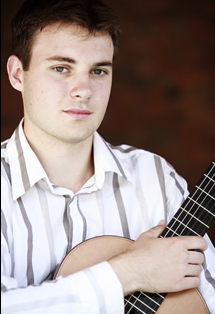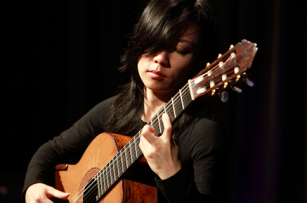Six weeks. That’s all we have left (miracles aside) of the Pacific Road Arts Centre on Shore Road in Birkenhead. At the end of 2011, the council will be putting it up for sale. The only gigs here will be at special request. If you have a Facebook account, you can go and show your support here. So if you have time and tickets, get yourself over and catch some of the last guitar festival events to be hosted at the venue. Personally I’ll be very sad to see the place close. It is a great venue. I’ll heading back next week to see Xuefei Yang and, in December, I will revisit the place to see Glenn Tilbrook (of Squeeze fame). If you’ve never seen him live, I highly recommend it – an amazing performer.
However, on this occasion I took my seat with the rest of the distinguished clientele (Mike McCartney, the roving members of the Chester Guitar Circle) to enjoy the dual virtuosity of the Katona Twins. These two have played all over the world to audiences that number in the thousands. To have them here on the doorstep at our little venue was a real honour. (Ok they live here, but nevertheless…still an honour)
Anyone who knows the work of these two performers will understand that this would not be a traditional classical guitar recital. The Katona Twins are a fusion of classical, flamenco and modern styles and musical genres. Playing (dare I say, identical, twin,) electro-accoustic/classical guitars and walking about the stage…what ARE they thinking? But of course, this is what they do. And what they do, they do very well indeed.
Opening with the Overture from the Barber of Seville (Rossini), the duo wasted no time in loosening up the phalanges and gave a glimpse of the impeccable accuracy of their duet playing.
The duo proceeded to perform their arrangement of Bohemian Rhapsody. A remarkable single guitar arrangement of this is played by the virtuoso Edgar Cruz but the divestment to two guitars makes the whole thing somewhat smoother and less fraught.
Just to keep the audience on their toes, we made a quick leap backwards 200 years to Boccherini. The Fandango with its flamenco stylings of fast rasgueados, tremelos and “castanet” drummings on the guitar body is an extremely challenging piece for us mere mortals. This was played with nonsensical accuracy by the two.
Clearly the Liverpool Guitar Ensemble’s recent showcase of Come Together by The Beatles has been an inspiration to the Katona Twins. Their performance was, well, how can I put it….quite good. Ok, this is possibly an understatement. If we had a straw poll of who’s was rendition was better, I suspect I know who’s might nip into an early lead. Still I’m very proud of ours.
The gut twisting time travel continued as we shot back to the baroque period. The last two pieces of the first set were by Scarlatti. The first, a sonata in Cm was unsullied by Katonan hand and beautifully played…however the second, Metamorphosis, is definitely a unique arrangement. I’m no Domenico Scarlatti expert but I’m reasonably certain he didn’t use drum solos and blues scales. However, this piece is a perfect example of what the Katona Twins are about – it is a microcosm of what they do. They have taken the essence of the original piece, and made a new modern work that is exciting and entertaining, and which brings the guitar alive for new audiences. We, the Liverpool Guitar Society, can learn much from these two – this is something our ensemble aspires to do.
And then there was beer.
The second set opened with a world premiere performance of an, as yet, unnamed piece written by Peter. It is based on the novel The Brothers Karamazov by Dostoyevsky (hey, you want art? you got art!). This was a multi-faceted piece and, it seemed to me, had rhythms reminiscent of mazurka and musical structures reminiscent of Eastern Europe. This could be the Russian influence of Dostoyevsky or the Hungarian influence of the twins’ origins…or I could be mistaken altogether! It was a quite wonderful and varied piece and I can honestly see it becoming part of the twins’ regular playlist.
The four pieces from Carmen (Bizet), I have no doubt, elicited the greatest applause from the audience. For a start this is a popular work, yes, but the pieces were played absolutely note-perfect – the very definition of crowd-pleaser. We were treated to Seguidilla, Danse Boheme, Aragonaise and Les Toreadors.
A prime example of the skills required in duet playing was demonstrated in the next piece, the Spanish Dance No.2 by Granados. This is a sublime piece with a section where both players are playing artificial harmonics together in ritenuto. I swear there wasn’t a single note out of sync. Maybe it’s the mysterious power of the twin, maybe it was a cheat and was really a recording….but I suspect the truth is they’re just damned good at this. The crowd loved Carmen – I loved this, and my socks were duly blown off.
A further world premiere piece penned, this time, by Zoltan preceded a Katona-style take on Vivaldi, and the twins closed the concert with virtuoso performances of De Falla‘s Pantomime and Firedance.
Encores of Albeniz‘s Mallorca and another Katona-esque arrangement of The Doors (Light My Fire) known as Doors of Fire….(a good name, since Fire Doors seems a bit… well… functional).
It’s not difficult to see why these two are popular, and pull in crowds in big numbers. They make the guitar accessible to all. Anyone who has any appreciation of the instrument or music in general will be entertained here. Again, this is an aim of our Society, to bring the beauty of the guitar to all.
There is one down-side in my opinion. The use of pickup-only guitars does seem to rob the instrument of much of its raw tonal variation. There’s no string swoosh and the reverb from the PA smooths over any cracks there might possibly be. Personally, those little imperfections are what make the guitar sound the way it does and I was disappointed in this regard.
But on the whole, it was an amazing performance and a lesson for all players who wish to take on the might of the guitar ensemble. Interestingly, the arrangements transfer the lead from player to player in a very seamless way and there isn’t a dominant player. So get practicing – it’ll be a while before you’re as tight as these two.
Steve Gaskell
LGS
 Working in conjunction with Hope University, Liverpool Guitar Society are very pleased to be able to promote a concert by Liverpool born, award winning guitarist Steven Joseph Hickey, on Friday 17th February 2012 at the Capstone Theatre in Liverpool.
Working in conjunction with Hope University, Liverpool Guitar Society are very pleased to be able to promote a concert by Liverpool born, award winning guitarist Steven Joseph Hickey, on Friday 17th February 2012 at the Capstone Theatre in Liverpool.


